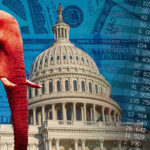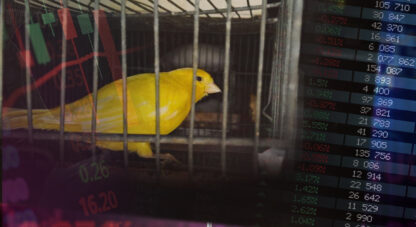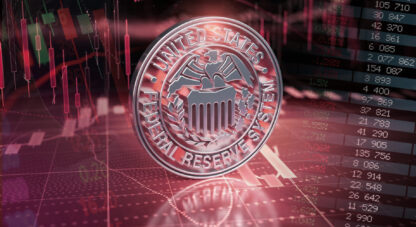What ever happened to “Six Sigma”? GE was one of the most beloved and hyped S&P500 stocks during the late-nineties Bubble Era. With “visionary” Jack Welch at the helm, GE was being transformed into a New Age industrial powerhouse – epitomizing the greater revolution of the U.S. economy into a technology and services juggernaut.
GE evolved into a major financial services conglomerate, riding the multi-decade wave of easy high-powered contemporary finance and central bank backstops. GE Capital assets came to surpass $630 billion, providing the majority of GE earnings. Wall Street was ecstatic – and loath to question anything. GE certainly had few rivals when it came to robust and reliable earnings growth. Street analysts could easily model quarterly EPS (earnings per share) growth, and GE would predictably beat estimates – like clockwork. Bull markets create genius.
It’s only fitting. With a multi-decade Credit Bubble having passed a momentous inflection point, there is now mounting concern for GE’s future. Welch’s successor, Jeffrey Immelt, announced in 2015 that GE would largely divest GE Capital assets. These kinds of things rarely work well in reverse. Easy “money” spurs rapid expansions (and regrettable acquisitions), while liquidation phases invariably unfold in much less hospitable backdrops. Immelt’s reputation lies in tatters, and GE today struggles to generate positive earnings and cash-flow.
When markets are booming and cheap Credit remains readily available, Wall Street is content to overlook operating cash flow and balance sheet/capital structure issues. Heck, a ton of money is made lending to, brokering loans for and providing investment banking services to big borrowers. That has been the case for the better part of the past decade (or three). No longer, it appears, as rather suddenly balance sheets and debt matter.
After ending 1994 with Total Liabilities (TL) of $158 billion (total equity $28bn), GE TL closed the nineties at $357 billion. Over the subsequent five boom years, TL increased to $382 billion, $425 billion, $507 billion, $563 billion and then 2004’s $627 billion. TL peaked in Q2 2008 at $720 billion (total equity $127bn). A slimmed down GE ended Q3 2018 with TL of $263 billion supported by $48 billion of Total Equity. GE finished the quarter with Short-Term Debt of $15.2 billion and Long-Term Debt of $100 billion.
GE CDS (Credit default swap) prices surged 24 bps Friday and 86 bps for the week, to 259 bps. This was after beginning 2018 at 41 bps. It’s worth noting that GE CDS closed this week at the highest level since the Fed “exit strategy” mini-panic back in 2011. But rather than commencing an exit from its bloated crisis-era balance sheet, the Fed proceeded over the next three years to double holdings again, to $4.5 TN. This extended GE’s lease on life, along with the fortunes of scores of aggressive borrowers. Perhaps a $9.0 TN Fed balance sheet could save GE.
Most of GE’s long-term debt is rated BBB+, “investment grade” but only a couple notches from high-yield (BB+). The worry is that downgrades will push GE bonds to junk, forcing liquidation by funds and holders restricted to investment-grade holdings. “Moneyness of Risk Assets” has been a key analytical construct throughout this reflationary cycle (an evolution of “Moneyness of Credit” from the mortgage finance Bubble period). Fed (and global central bank) rate, QE, and market backstop policies incentivized (coerced) savers into the risk markets, especially in perceived lower-risk equities and fixed-income. With market yields way below investment return bogeys, many (pensions managers) were compelled to boost returns with leverage. Literally Trillions flowed into perceived safe and liquid “money-like” ETF shares. The flood of “money” into (higher yielding vs. CDs and Treasuries) investment-grade ETF products ensured the easiest Credit Availability imaginable for companies to borrower for capital investment or, more often, stock buybacks and M&A.
November 16 – Bloomberg (Brian Smith and Jeremy Hill): “Investment-grade bond spreads surged to the widest level in two years as a rash of concerns about corporate debt dented investor confidence. The spread on the Bloomberg Barclays U.S. IG Corporate Bond Index widened to 128 bps over Treasuries at the close Thursday, the widest since December 2016. The 6 bps jump was the most since the Brexit vote two years ago. Bond ‘buyers have been relatively indifferent to corporations, and they focused more on rating,’ said David Sherman, president of Cohanzick Management LLC. ‘And now they’re starting to bifurcate the ‘haves’ and the ‘have-nots.””
November 15 – Reuters (Trevor Hunnicutt): “U.S. fund investors are maintaining a wary position when it comes to bonds, pulling more cash after record withdrawals in October, Lipper data showed… Taxable bond mutual funds and exchange-traded funds (ETFs) based in the United States posted $1.2 billion in withdrawals during the week ended Nov. 14, Lipper said. Investors pulled $131 million from municipal bond funds in the eighth straight week of withdrawals for those products. In October, more than $53 billion tumbled out of U.S.-based taxable bond funds, the largest withdrawals on records dating to 1992, according to Lipper.”
Losses are mounting, and liquidity is waning. U.S. corporate Credit is losing its “moneyness,” with profound financial and economic ramifications. The June 2007 subprime eruption marked the inflection point for the “moneyness” of mortgage Credit. The “marginal” borrower/buyer lost access to cheap Credit, commencing a spectacular cycle’s downside. Yet it was when the marketplace questioned the safety and liquidity of previously perceived “moneylike” “AAA” mortgage securities (and the money market borrowings of those heavily leveraged in “AAA”!) that full-fledged crisis took hold.
I remember the argument all too well. “Subprime doesn’t matter.” Arguing that losses would amount to no more than $40 to $50 billion, subprime was viewed by many in late-2007 as almost trivial in comparison to U.S. wealth in the many tens of Trillions. The market in “BBB” corporates has ballooned during this cycle to about $3.0 TN. With the U.S. economy and stock market booming, “BBB” has been viewed as virtually bulletproof. Well into 2008, “AAA” was bulletproof.
With major outflows from investment-grade funds, Credit availability is now tightening for the “marginal” “BBB” Credits. Tighter Credit conditions pressure GE and other borrowers that have for years feasted on the loosest finance ever. Heavily levered companies will face higher – in some cases significantly higher – rates when refinancing debt. This should mark a key inflection point for stock buybacks and M&A. These firms will also be vulnerable to the downside of the Credit Cycle, with deteriorating economic prospects and deflating asset prices. Risk is high that huge quantities of “BBB” rated bonds will turn to junk (“fallen angels”). And as one issuer stumbles, a nervous marketplace will fret the next victims of a rapidly tightening marketplace. Contagion at the “Core.” In the event of a major liquidation, who will step up to buy?
November 16 – Fitch Ratings: “Fitch Ratings has downgraded PG&E Corporation’s (PCG) and Pacific Gas and Electric Company’s (PG&E) Long-Term Issuer Default Ratings (IDR) to ‘BBB-‘ from ‘BBB’ and placed them on Rating Watch Negative… The rating action reflects the enormous increase in the size, intensity and destructive power of wildfires in California during 2017-2018, the implications of potential, vastly increased third-party liabilities under inverse condemnation and uncertainties regarding full and timely recovery of such costs.
How time flies. It’s now been about six weeks since Chairman Powell’s, “we’re a long way from neutral at this point, probably.” GE CDS has about tripled (83 to 259 bps) over this short period, while investment-grade corporate (Bloomberg/Barclays) spreads have surged from 105 to an almost three-year high 128 bps. Especially with this week’s dramatic widening of corporate spreads, the Fed’s attention has surely been piqued. A pullback in equities is not only unalarming to Federal Reserve officials, it’s likely welcomed. The prospect of illiquidity and dislocation in corporate Credit sets alarm sirens blaring.
November 16 – CNBC (Jeff Cox): “The Federal Reserve is close to the point of being ‘neutral’ on interest rates and should predicate further increases on economic data, the central bank’s vice chairman said Friday. Recent appointee Richard Clarida told CNBC’s Steve Liesman that nearly three years of increases have brought the Fed’s short-term interest rate near where it is neither restrictive nor stimulative, a key consideration when considering the future path of monetary policy. ‘As you move in the range of policy that by some estimates is close to neutral, then with the economy doing well it’s appropriate to sort of shift the emphasis toward being more data dependent,’ Clarida said…”
Two-year Treasury yields sank 12 bps this week to 2.81%. Chairman Powell struck a balanced tone during his Wednesday evening presentation, falling short of the full retreat from relative hawkishness the market was yearning for. About 36 hours (and 50 bps added to GE CDS) later, vice chairman Clarida came closer to the mark.
I’ll assume the White House similarly recognizes the rapidly deteriorating financial backdrop. The President’s Friday comments ensured a positive end to an ominous week.
November 16 – Bloomberg (Shannon Pettypiece and Shawn Donnan): “President Donald Trump said he is optimistic about resolving the U.S. trade dispute with China after receiving a response to his demands from Beijing, ahead of a widely anticipated meeting with China’s Xi Jinping in Argentina… Trump told reporters Friday that the Chinese response was largely complete but was missing four or five big issues, signaling that tough discussions still need to take place between the two sides as they head into the Nov. 30-Dec. 1 meetings… “China wants to make a deal… They sent a list of things they are willing to do, which is a large list and it is just not acceptable to me yet. But at some point I think that, we are doing extremely well with respect to China.’”
President Trump added, “I don’t want to put them in a bad position. I want to put them in a great position.” This was a notably softer tone than the borderline gloating from a few weeks back (with Chinese stocks in a tailspin as U.S. equities hovered near all-time highs). I took exception with the President’s approach back then. Not only would it surely enrage Beijing, I’m reminded of the old, “If you live in a glass house, don’t throw stones”. With Global Crisis Dynamics having landed at the Core, latent U.S. fragilities have begun bubbling to the surface. This may motivate the administration to ink a trade deal with China. On the other hand, it may strengthen Chinese resolve. Beijing may see the advantage of playing long ball, believing their tightly controlled system is better prepared today to weather a global crisis than their U.S. competitor.
As for Global Crisis Dynamics, markets seem to turn more unstable by the week. There must be excruciating pain out there in the leveraged speculating community. The crude liquidation ran unabated this week, with (December) WTI sinking another $3.73 to $56.46. In a stunning move for such a major market, WTI is now down 25% from October 3rd highs ($76.72). And if you had a “pairs trade” long crude against a short in natural gas, you had a really miserable go of it. Natural gas traded to $4.93 intraday in Wednesday’s session, up over 50% since October 3rd.
Speaking of pain, Italian 10-year yields were up another nine bps this week to 3.49%. And with German bund yields down four bps (0.37%), the Italian to German yield spread widened 13 to 312 bps. Italian banks were slammed 3.8%. Greece CDS jumped 24 bps to a near one-year high 417 bps. European periphery bonds were under pressure, with spreads (to bunds) widening 23 bps in Greece, eight bps in Spain and seven bps in Portugal.
While markets would like to take a constructive view of the less hawkish tone from Fed officials, there’s little the Fed can do to sooth unstable markets. At this point, speculators are positioned for higher rates and yields. Sudden dovish talk sparks a reversal of hedges in the Treasury market, with sinking yields only exacerbating spread widening (and deleveraging) throughout corporate Credit. Five-year Treasury yields sank 16 bps this week. The unstable MBS marketplace saw benchmark yields drop 14 bps.
It’s also a fair assumption that the speculators are positioned long the U.S. dollar, especially versus emerging market currencies. Clarida’s Friday morning comments heightened currency market volatility, with the dollar index declining 0.5%. The heavily shorted emerging equities (EEM) ETF rallied 2.8% this week. Rather ominously, Mexico didn’t participate in the rally. Mexican equities sank 4.4%, as 10-year (peso) yields surpassed 9.0% for the first time in years. Mexico’s CDS jumped 11 to 146 bps.
Here at home, Goldman Sachs CDS surged a notable 22 to 91 bps, the high going back to January 2017. Morgan Stanley (+13), Bank of America (+10), Citigroup (+10) and JPMorgan (+10) all posted double-digit CDS price increases this week.
But it was the 13 bps jump in investment-grade spreads (to 2-yr highs) that I place at the top of this week’s notable market developments. The LQD investment-grade ETF closed Thursday at the lowest level since 2011 (negative 5.3% y-t-d return). So, my bearish imagination returns to the $3.0 TN of BBB corporate bonds. How much is held by investors that have little appreciation for mounting risks? How vulnerable are ETFs to a run? How much corporate Credit is held on leverage? Heavy leverage imbedded in derivatives? And is it outrageous to ponder the speculator community moving to deleverage, anxious to get out in front of a surge of ETF outflows?
Markets this week appeared to begin discounting a troubling scenario in corporate Credit. I believe we are also beginning to witness a historic inflection point with respect to economic structure. If a major tightening in financial conditions and corporate Credit Availability are now unfolding, then there are enormous numbers of uneconomic and negative cash-flow enterprises that face Rude Awakenings. As the New York Times put it, “General Electric may be the Canary in the Credit Market’s Coal Mine.”
November 16 – Bloomberg (Lisa Lee): “The U.S. leveraged loan market’s benchmark price index dropped to a two-year low yesterday as credit and equity markets slumped. Besides negative vibes from the junk bond market, investors blame an increase in supply as issuers piled in to capitalize on robust demand for floating rate assets. ‘We have these pockets where supply catches up to demand,’ said Chris Remington, portfolio manager at Eaton Vance, one of the biggest U.S. investors in leveraged loans…”
Notable as well this week, new China Credit data.
November 13 – Reuters (Kevin Yao and Lusha Zhang): “China’s credit growth slowed sharply in October, despite pressure by regulators on banks to help keep cash-starved companies afloat, pointing to further weakening in the economy in coming months. While October is typically a slow month for Chinese credit, growth in key gauges such as total social financing and money supply fell to record lows, reinforcing views that policymakers will need to step up efforts to revive flagging investment… Chinese banks extended 697 billion yuan ($100.23bn) in net new yuan loans in October…, much less than expected. Analysts polled by Reuters had predicted new loans of 862 billion yuan in October, down from 1.38 trillion yuan in September… Household loans, mostly mortgages, fell to 563.6 billion yuan from 754.4 billion yuan in September. Household loans accounted for 80.9% of total new loans in October, versus 54.7% in the preceding month…”
China Aggregate Financing dropped to 579 billion yuan ($84bn), down from September’s 1.178 TN ($171bn), to the lowest monthly Credit expansion since July 2016 (479bn yuan). Estimates were at 1.300 TN yuan. After 10 months, y-t-d Aggregate Financing of $1.925 TN is running 20% below comparable 2017. And while new bank loans slowed sharply from September (and recent months), it was still up somewhat from October 2017. Consumer Bank Loans slowed in October, although were still 25% above October 2017. Year-to-date new Bank Loans were up 17% from comparable 2017 (y-t-d Consumer loans up 18%). Meanwhile, “shadow bank” lending contracted (268bn yuan) in October.
For the Week:
The S&P500 declined 1.6% (up 2.3% y-t-d), and the Dow fell 2.2% (up 2.8%). The Utilities slipped 0.5% (up 2.8%). The Banks declined 0.8% (down 5.9%), and the Broker/Dealers fell 1.6% (down 0.3%). The Transports increased 0.6% (down 0.3%). The S&P 400 Midcaps dipped 0.9% (down 1.9%), and the small cap Russell 2000 fell 1.4% (down 0.5%). The Nasdaq100 dropped 2.4% (up 7.4%). The Semiconductors slipped 0.7% (down 2.6%). The Biotechs declined 1.7% (up 9.1%). With bullion recovering $12, the HUI gold index rallied 3.6% (down 22.7%).
Three-month Treasury bill rates ended the week at 2.30%. Two-year government yields declined four bps to 2.80% (up 92bps y-t-d). Five-year T-note yields sank 16 bps to 2.88% (up 67bps). Ten-year Treasury yields fell 12 bps to 3.06% (up 66bps). Long bond yields declined seven bps to 3.32% (up 58bps). Benchmark Fannie Mae MBS yields fell 14 bps to 3.92% (up 93bps).
Greek 10-year yields jumped 19 bps to 4.55% (up 48bps y-t-d). Ten-year Portuguese yields increased three bps to 1.98% (up 3bps). Italian 10-year yields rose nine bps to 3.49% (up 148bps). Spain’s 10-year yields gained four bps to 1.64% (up 7bps). German bund yields declined four bps to 0.37% (down 6bps). French yields dipped two bps to 0.76% (down 2bps). The French to German 10-year bond spread widened two to 39 bps. U.K. 10-year gilt yields fell eight bps to 1.41% (up 22bps). U.K.’s FTSE equities index declined 1.3% (down 8.8%).
Japan’s Nikkei 225 equities index dropped 2.6% (down 4.6% y-t-d). Japanese 10-year “JGB” yields declined two bps to 0.10% (up 6bps). France’s CAC40 declined 1.6% (down 5.4%). The German DAX equities index fell 1.6% (down 12.2%). Spain’s IBEX 35 equities index declined 0.9% (down 9.8%). Italy’s FTSE MIB index dropped 2.0% (down 13.6%). EM equities were mixed but generally outperformed. Brazil’s Bovespa index rallied 3.4% (up 15.9%), while Mexico’s Bolsa sank 4.4% (down 14.3%). South Korea’s Kospi index increased 0.3% (down 15.2%). India’s Sensex equities index gained 0.8% (up 4.1%). China’s Shanghai Exchange rallied 3.1% (down 19.0%). Turkey’s Borsa Istanbul National 100 index gained 0.8% (down 18.8%). Russia’s MICEX equities index fell 1.3% (up 12.5%).
Investment-grade bond funds saw inflows of $755 million, and junk bond funds posted inflows of $487 million (from Lipper).
Freddie Mac 30-year fixed mortgage rates were unchanged at 4.94% (up 99bps y-o-y). Fifteen-year rates gained three bps to 4.36% (up 105bps). Five-year hybrid ARM rates were unchanged at 4.14% (up 93bps). Bankrate’s survey of jumbo mortgage borrowing costs had 30-yr fixed rates down nine bps to 4.74% (up 61bps).
Federal Reserve Credit last week increased $2.8bn to $4.105 TN. Over the past year, Fed Credit contracted $318bn, or 7.2%. Fed Credit inflated $1.294 TN, or 46%, over the past 315 weeks. Elsewhere, Fed holdings for foreign owners of Treasury, Agency Debt gained $5.0bn last week to $3.420 TN. “Custody holdings” were up $51bn y-o-y, or 1.5%.
M2 (narrow) “money” supply declined $18.3bn last week to $14.275 TN. “Narrow money” gained $518bn, or 3.8%, over the past year. For the week, Currency declined $0.7bn. Total Checkable Deposits dropped $37.7bn, while Savings Deposits gained $4.2bn. Small Time Deposits rose $4.6bn. Retail Money Funds increased $8.2bn.
Total money market fund assets gained $12.3bn to $2.920 TN – the high going all the way back to April 2010. Money Funds gained $180bn y-o-y, or 6.6%.
Total Commercial Paper added $0.4bn to $1.084 TN. CP gained $51.6bn y-o-y, or 5.0%.
Currency Watch:
November 13 – CNBC (Huileng Tan): “Market uncertainty tied to the ongoing U.S.-China trade war has spurred more transactions than ever before between the American dollar and the Chinese yuan in recent months. Much of that volume comes as businesses and investors with exposure to the Chinese market are looking to hedge their foreign exchange risk. Many of them are looking to buy into the strengthening dollar, and that’s stoked speculation that Chinese authorities are intervening in the market to defend their currency, boosting trading volumes to new highs in the process… Against that backdrop, the Hong Kong Exchange and the Singapore Exchange – two main centers for dollar-yuan currency futures – have both reported record trading volumes in the dollar-offshore yuan pair this year. On the Hong Kong exchange, single-day trading volumes between the offshore yuan and the dollar hit all-time highs on July 3 and July 4. At the Singapore Exchange, August’s dollar-offshore yuan futures trading posted a dramatic rise in volume, surging over 250% from a year ago.”
The U.S. dollar index slipped 0.4% to 96.465 (up 4.7% y-t-d). For the week on the upside, the South African rand increased 2.6%, the New Zealand dollar 2.1%, the Australian dollar 1.5%, the Japanese yen 0.9%, the Swedish krona 0.9%, the euro 0.7%, the Swiss franc 0.6%, the Canadian dollar 0.5% and the Singapore dollar 0.4%. For the week on the downside, the British pound declined 1.1%, the Brazilian real 0.2%, the Mexican peso 0.2% and the Norwegian krone 0.1%. The Chinese renminbi increased 0.27% versus the dollar this week (down 6.22% y-t-d).
Commodities Watch:
The Goldman Sachs Commodities Index dropped 2.5% (down 2.3% y-t-d). Spot Gold rallied 1.0% to $1,222 (down 6.3%). Silver gained 1.7% to $14.382 (down 16.1%). Crude sank another $3.73 to $56.46 (down 7%). Gasoline dropped 2.7% (down 12%), while Natural Gas spiked 14.9% (up 45%). Copper rallied 4.7% (down 15%). Wheat jumped 2.6% (up 21%). Corn rose 1.6% (up 7%).
Market Dislocation Watch:
November 13 – Bloomberg (Robert Burgess): “More so than any other market, credit is all about confidence. Yes, fundamentals such as revenue, cash flow and leverage matter, but as was seen with Lehman Brothers…, Enron Corp. and WorldCom Inc., when a borrower loses the confidence of its lenders, things can go downhill pretty quickly. And right now, some pretty influential people in the credit market are sounding less than confident. The extra yield investors demand to own investment-grade corporate bonds instead of U.S. Treasuries expanded on Tuesday by the most since May as legendary Guggenheim Investment Management Chief Investment Officer Scott Minerd tweeted that ‘the slide and collapse in investment-grade credit has begun.’”
November 13 – Bloomberg (Molly Smith): “General Electric Co. may still have a relatively solid investment-grade rating, but investors aren’t taking their chances. They’re snapping up derivatives that protect against losses on the company’s debt. The cost to insure against a default by GE for five years climbed to as high as 211 bps in early trading… That’s almost double what it cost just two weeks ago, and it’s the kind of level that hasn’t been seen for the company since the waning days of the global financial crisis.”
November 15 – Wall Street Journal (Matt Wirz): “Wall Street has a GE problem. General Electric Co. amassed $115 billion of debt on a reputation as one of the U.S.’s safest borrowers. But revelations of losses and questions about its accounting have brought financial markets to a pivotal moment. GE had a sterling triple-A credit rating as recently as 2015. This month, investors have pummeled its bond prices into junk territory. Once a giant issuer of ultrasafe commercial paper, it now relies on $41 billion in revolving credit lines from more than 30 banks-the corporate finance equivalent of a wallet stuffed with credit cards.”
November 14 – New York Times (Ivan Penn and Peter Eavis): “As wildfires ravage large swaths of California for a second year, one of the state’s biggest utilities has declared that it faces billions of dollars in potential liability – far more than its insurance would cover. The potential losses could leave the company’s customers on the hook to pay the bill, exposing businesses and consumers to higher costs. The utility, Pacific Gas and Electric Company, could even face bankruptcy, putting pressure on the state for a bailout. With its financial liabilities mounting, the company’s shares dropped by more than 20% on Wednesday. More than half of its market value has been wiped out since late last week as the fires have spread.”
November 15 – Reuters (Elizabeth Piper, Kylie MacLellan, William James): “Prime Minister Theresa May vowed to fight for her draft divorce deal with the European Union on Thursday after the resignation of her Brexit secretary and other ministers put her strategy and her job in peril. Just over 12 hours after May announced that her cabinet had agreed to the terms of the deal, Brexit minister Dominic Raab and work and pensions minister Esther McVey resigned.”
November 14 – Reuters (Jan Strupczewski): “Italy re-submitted its draft 2019 budget to the European Commission with the same growth and deficit assumptions as a draft rejected for breaking European Union rules, stepping up its showdown with the EU over its fiscal policy. The Commission, which is the guardian of EU laws, sent back Italy’s previous draft last month to be revised because its growth assumptions were too high, the deficit was to be bigger rather than smaller and debt was to be stable instead of lower. But Italy’s euro-sceptic government of the far-right League and populist Five Star movement dug in its heels on the main assumptions of the draft and, defying a call from all euro zone finance ministers last week, stuck to its initial plan.”
November 14 – Bloomberg (Narae Kim, Carrie Hong and Annie Lee): “China’s biggest lender pulled an offering of dollar bonds in the U.S. market on Wednesday, adding to concern that American investor demand for Chinese offerings is dwindling amid the trade war. Industrial & Commercial Bank of China Ltd. had been marketing three-year and five-year floating-rate notes through its New York branch, then decided not to proceed with pricing…”
November 13 – Financial Times (Colby Smith): “For the second time in nearly as many weeks, incoming President Andrés Manuel López Obrador, also known as Amlo, has rattled investors. First it was Mr López Obrador’s decision at the end of October to uphold the ‘will’ of the people and cancel the country’s largest ongoing infrastructure project, a new airport in Mexico City. Now the banking sector has found itself in his party’s crosshairs, leading many to worry about how much riskier Mexican assets could get after he takes office on December 1. Late last week, the Senate leader of his Morena party announced plans to ban a range of fees that banks charge clients.”
November 15 – Bloomberg (Justin Villamil): “Mexican credit default swaps jumped to their highest levels since February 2017, tracking a selloff in local assets sparked by incoming Andres Manuel Lopez Obrador’s increasingly interventionist stance on the economy. CDS spreads… added 3.2 bps to 152.187 on Thursday, cementing a six-day rising streak. Decisions by the administration to cancel a $13 billion partially built airport project in Mexico City and proposals to cut some bank fees contributed to an increased risk environment for investors.”
Trump Administration Watch:
November 13 – Washington Post (Josh Rogin): “When President Trump meets Chinese President Xi Jinping in Argentina later this month, the escalating tension between the world’s two global powers will face a crucial test. If China wants to avoid an all-out cold war with the United States and its partners, it must fundamentally change its behavior, according to Vice President Pence. The United States, he assured me, won’t back down… Pence told me in an interview that Trump is leaving the door open for a deal with Xi in Argentina, but only if Beijing is willing to make massive changes that the United States is demanding in its economic, military and political activities. The vice president said this is China’s best (if not last) chance to avoid a cold-war scenario with the United States. ‘I think much of that will depend on Argentina,’ Pence said. ‘The president’s attitude is, we want to make sure they know where we stand, what we are prepared to do, so they can come to Argentina with concrete proposals that address not just the trade deficit that we face… We’re convinced China knows where we stand.’”
November 13 – Wall Street Journal (James Mackintosh): “In just over two weeks, President Trump will meet Chinese President Xi Jinping in Buenos Aires, and we might get an answer to one of the biggest questions hanging over markets: Is Mr. Trump’s trade battle with China really about trade, or about geopolitical rivalry? Much follows for investors. If it is about trade, a deal is possible, and Mr. Trump’s track record suggests it is fairly likely. If it is about containing China, it may be time to hunker down in preparation for a new cold war. The administration’s China hawks have been increasingly vocal recently, pushing the idea of containment. On Friday, one launched an outspoken attack on Wall Street’s ‘globalist billionaires’ trying to get a trade deal. Meanwhile, the pro-trade faction led by Treasury Secretary Steven Mnuchin is working behind the scenes in an attempt to make progress before the Xi-Trump meeting. Which side Mr. Trump is on is unclear, although he has talked about securing a deal with China.”
November 15 – Bloomberg (Shawn Donnan, Saleha Mohsin and Jenny Leonard): “Chinese officials have outlined a series of potential concessions to the Trump administration for the first time since the summer as they continue to try to resolve a trade war, according to three people familiar with the discussions. The commitments for now fall short of the type of major structural reforms that President Donald Trump has been demanding, two of the people said… One person said that talks between the world’s two largest economies are continuing and constructive. As a result, one of the people said, it raised doubts over how substantive a deal Trump could make with Chinese counterpart Xi Jinping when the two leaders meet later this month on the sidelines of the Group of 20 summit in Buenos Aires.”
November 14 – Bloomberg (Erik Wasson and Andrew Mayeda): “President Donald Trump’s new trade deal with Canada and Mexico needs changes to secure support from Democrats, according to a senior House Democrat in line to play a leading role on trade policy in the new Congress. There needs ‘to be not only changes in the legislation but more enforcement’ if the Trump administration wants votes from Democrats, said New Jersey Representative Bill Pascrell, who is positioned to chair the Ways and Means Trade subcommittee…”
November 14 – CNBC (Jeff Cox): “Rep. Maxine Waters, poised to take over the powerful House Financial Services Committee when the new Congress convenes in January, laid down the law… about the future of banking regulation. Speaking ahead of remarks by Randal Quarles… the California Democrat said efforts to loosen the reins on Wall Street financial institutions won’t be tolerated should she be committee chair, as expected. ‘Make no mistake, come January, in this committee the days of this committee weakening regulations and putting our economy once again at risk of another financial crisis will come to an end,’ Waters said.”
November 11 – Wall Street Journal (Andrew Ackerman): “Split power in Congress means lawmakers are unlikely to overhaul how the government backstops more than half the U.S. mortgage market. That provides an opportunity for the Trump administration to take steps on its own-and the industry is lobbying to soften any potential changes. In the short term, congressional inaction is likely good news for the housing market as home sales and prices weaken amid rising interest rates. But the White House is expected to consider steps in the coming months that could reduce the government’s footprint in backstopping the market through mortgage-finance giants Fannie Mae FNMA and Freddie Mac… There are limits on what the administration can do with Fannie Mae and Freddie Mac absent legislation.”
Federal Reserve Watch:
November 14 – Reuters (Howard Schneider): “A ‘really strong’ U.S. economy is likely to continue growing, but softness in housing and high levels of corporate debt have caught the Federal Reserve’s eye, Chairman Jerome Powell said… Powell, quizzed by Dallas Federal Reserve President Robert Kaplan in an hour-long conversation, was not asked directly about possible further rate increases, but said nothing to counter the expectation that the Fed will raise rates again when it meets in December… ‘Slowing growth abroad. The tax cuts and spending increases that were enacted are providing some real boost right now, but that impetus is going to wear off over time,’ Powell said when asked to list the “headwinds” the economy may face in coming months.”
November 15 – Bloomberg (Jeanna Smialek, Craig Torres and Rich Miller): “Federal Reserve Chairman Jerome Powell said the U.S. economy is strong but could face headwinds next year as policy makers weigh how far and fast to raise interest rates. ‘We have to be thinking about how much further to raise rates, and the pace at which we will raise rates,’ Powell said during a question and answers session… moderated by Dallas Fed chief Robert Kaplan. The goal is to ‘extend the recovery, expansion, and to keep unemployment low, to keep inflation low.’ While generally upbeat about the U.S. economic outlook, Powell listed potential challenges including slowing demand abroad, fading fiscal stimulus and the lagged effect on the economy of the Fed’s eight rate increases since late 2015. ‘These are things we are well aware of though. We know that when we’re making policy and we think about those and kind of have a sense of what they might be,’ he said.”
November 15 – Financial Times (Mamta Badkar, Joe Rennison James Politi): “The Federal Reserve will launch a sweeping assessment of its monetary policy tools and the way in which it communicates its decisions in 2019 – a new effort by chairman Jay Powell to boost the transparency and effectiveness of the US central bank. In a statement…, the Fed said it would review the ‘strategies, tools and communication practices’ it uses to convey monetary policy.”
U.S. Bubble Watch:
November 16 – Reuters (Jonathan Spicer): “The total debt shouldered by Americans has hit another record high, rising to $13.5 trillion in the last quarter, while an unusual jump in student-loan delinquencies could provide another signal that the U.S. economic expansion is growing old. Flows of student debt into serious delinquency – of 90 or more days – rose to 9.1% in the third quarter from 8.6% in the previous quarter, the Federal Reserve Bank of New York reported… That propelled the biggest jump in the overall U.S. delinquency rate in seven years… Total household debt, driven by a $9.1 trillion in mortgages, is now $837 billion higher than its previous peak in 2008… Indebtedness has risen steadily for more than four years and sits more than 21% above a trough in 2013. The $219 billion rise in total debt in the quarter ended September 30 was the biggest jump since 2016.”
November 15 – Bloomberg (Katia Porzecanski and Katherine Burton): “The hike in interest rates triggered by faster growth from U.S. tax cuts may cause the bubble in credit to pop, billionaire hedge fund manager Paul Tudor Jones said. ‘We’re going to stress test our whole corporate credit market for the first time,’ Jones said… ‘From a markets perspective, it’s going to be interesting. There probably will be some really scary moments in corporate credit.’ Jones, who heads the $7 billion Tudor Investment Corp., said zero and negative interest rates have encouraged excess lending, putting the markets in a perilous condition. He said today’s levels of leverage could be systemically threatening even if policy makers respond appropriately. ‘The end of the 10-year run is going to be a really challenging time for policy makers going forward,’ he said.”
November 14 – Reuters (Lucia Mutikani): “U.S. consumer prices increased by the most in nine months in October amid gains in the cost of gasoline and rents, pointing to steadily rising inflation that likely will keep the Federal Reserve on track to raise interest rates again next month… The… Consumer Price Index rose 0.3% last month, the biggest gain since January… In the 12 months through October, the CPI increased 2.5%, picking up from September’s 2.3% rise… Excluding the volatile food and energy components, the CPI climbed 0.2%… In the 12 months through October, the core CPI increased 2.1% after advancing 2.2% in September.”
November 11 – Wall Street Journal (Kate Davidson and Daniel Kruger): “In the past decade, U.S. debt held by the public has risen to $15.9 trillion from $5.1 trillion, but financing all of that debt hasn’t been a problem. Low inflation and strong global demand for safe U.S. Treasury bonds held the government’s interest costs down. That’s in the process of changing. Interest rates are rising as inflation normalizes around the Federal Reserve’s 2% target. That and the sheer scale of debt being accumulated by the federal government has put the U.S. on a path of rising interest costs… In 2017, interest costs on federal debt of $263 billion accounted for 6.6% of all government spending and 1.4% of gross domestic product, well below averages of the previous 50 years. The Congressional Budget Office estimates interest spending will rise to $915 billion by 2028, or 13% of all outlays and 3.1% of gross domestic product.”
November 13 – Reuters (Jason Lange): “The U.S. federal government ran a $100 billion deficit in October, the first month of the new fiscal year… The deficit was in line with analysts’ expectations. The Treasury said federal spending rose 18% from the year-earlier month to $353 billion in October, while receipts were up 7% to $253 billion. When accounting for calendar differences, the government ran a deficit of $110 billion last month compared with $111 billion in October 2017.”
November 12 – Bloomberg (Martin Z. Braun): “The unfunded pension liabilities of U.S. states surpassed $1 trillion in fiscal 2017 and now represent 3.6% of state personal income, according to Fitch… Net pension liabilities grew 12% from fiscal 2016 because of increases in present value of future benefits and lackluster investment performance, Fitch said…”
November 13 – Financial Times (Richard Waters and Andrew Edgecliffe-Johnson): “The five US tech companies with the largest cash piles took advantage of President Trump’s tax reforms to spend more than $115bn in the first three quarters on buying back their own stock. The share buybacks so far this year by Apple, Alphabet, Cisco, Microsoft and Oracle, after the tax change came into force at the end of 2017, are nearly double what the companies spent in the whole of last year, making investors some of the biggest beneficiaries of a plan that was billed as a boost to US jobs. They also increased their capital investment by 42% compared with the same period last year, to $42.6bn…”
November 15 – Reuters: “U.S. retail sales rebounded sharply in October as purchases of motor vehicles and building materials surged, likely driven by rebuilding efforts in areas devastated by Hurricane Florence. The Commerce Department said… retail sales increased 0.8% last month also as households bought electronics and appliances. Data for September was revised down to show retail sales slipping 0.1% instead of nudging up 0.1%… Retail sales in October rose 4.6% from a year ago.”
November 13 – Associated Press: “The number of foreign students heading to U.S. colleges and universities fell again last year, the second straight decline after more than a decade of growth… Enrollment of new international students dropped by about 7% in fall 2017, according to an annual report… by the State Department and the Institute of International Education… The overall number of foreign students in the U.S. still increased slightly, by 1.5%, fueled by growing numbers of students who stayed for temporary work after graduation. But the number of newly arriving students slid to about 271,000, the lowest levels since 2013.”
China Watch:
November 11 – Financial Times (Gabriel Wildau): “Chinese President Xi Jinping has invoked a long discarded Maoist slogan to call on state-owned enterprises to make advanced components that are now mostly imported. Even as Mr Xi has sought to position China as a champion of globalisation amid the US retreat into protectionism, the call for ‘self-reliance’ highlights how Mr Xi is also advocating mercantilist policies that could reshape global supply chains. The US commerce department’s ban on US companies selling components to Chinese telecoms equipment maker ZTE earlier this year… exposed China’s vulnerability to such sanctions. ‘Internationally, advanced technology and key technology is more and more difficult to obtain. Unilateralism and trade protectionism have risen, forcing us to travel the road of self-reliance,’ Mr Xi told workers in September…”
November 14 – Reuters (Lusha Zhang, Stella Qiu and Ryan Woo): “Growth in China’s real estate investment in October cooled to a 10-month low and home sales fell again, as developers held back expansion plans in the face of broadly softening economic conditions. The property market… has been cooling in recent months, as land auctions tumbled and various tightening measures kept overall home sales in check. Property investment, which mainly focuses on residential but also includes commercial and office space, grew 7.7% in October from a year earlier, slowing from an 8.9% expansion in September…”
November 13 – Wall Street Journal (Nathaniel Taplin): “Chinese banks are now the biggest in the world by assets. Size, though, isn’t the same thing as maturity. A call from China’s top banking regulator late last week for half of new lending to go to private companies within three years has unnerved investors used to big banks making safe loans to other government-backed companies. Shares in Industrial & Commercial Bank of China, the world’s largest bank by assets, have fallen more than 2% since Thursday. State media walked back the tough talk Monday, declaring this won’t be a ‘hard’ target.”
November 11 – Bloomberg: “Chinese authorities clarified the requirements on banks to lend to private companies, after investors balked at what were seen as unprecedented government demands on lenders. Regulators won’t set specific targets for each bank, four of the nation’s state-run financial newspapers said in front-page stories… Firms should conduct appropriate due diligence rather than comply with the lending requirements ‘unconditionally,’ the China Securities Journal said.”
November 11 – Bloomberg: “Some Chinese banks are struggling to comply with unprecedented regulatory targets for credit to private companies because they aren’t sure who to lend to, a sign that authorities’ urgency to reverse an economic slowdown is muddying policy. The confusion stems from China Banking and Insurance Regulatory Commission chief Guo Shuqing’s statement… that at least a third of new loans should go to private companies, with the ratio going up to 50% in three years… The problem, according to senior executives at three banks who spoke on condition of anonymity for fear of alienating regulators, largely boils down to this: In a country where the state’s influence is felt everywhere, there remains little consensus on what, exactly, defines a ‘private’ company. That leaves the new policy open to misinterpretation and even potentially to gaming, they said.”
November 14 – Reuters (Adam Jourdan and Gaurav Dogra): “China Inc’s profit growth has fallen sharply while debt levels have recorded a rare drop, a Reuters analysis of earnings data shows – signs of strain brought on by Beijing’s crackdown on leverage as well as a trade war with the United States. Easy access to funds had long fueled growth for mainland Chinese firms but a concerted campaign by authorities to rid the financial system of excessive liquidity and rein in irrational corporate expansion is taking its toll… Chinese firms managed a combined net profit rise of just 3.9% in the third quarter, compared with jumps of 20-55% seen in each quarter for the past two years, according to the Reuters analysis of earnings for 1,950 firms…”
November 11 – Bloomberg: “Economists betting the People’s Bank of China will cut interest rates in the near future are still in the minority camp, but their voice is becoming louder. Analysts from Guotai Junan Securities Co., Citic Securities Co. and China Evergrande Group are seeing a rising chance the central bank will cut its benchmark rates in the near future, with some saying reductions could come in early 2019. China is likely to ‘lower benchmark deposit and lending interest rates to stabilize growth and support private small firms,’ as previous easing measures haven’t passed onto companies and individuals, Ming Ming, a former PBOC official and head of fixed income research at Citic Securities…, wrote…”
November 11 – Bloomberg: “China’s central bank said the global outlook is worsening and that it’ll tweak its policy in a sign that trade tensions with the U.S. are hurting the world’s second-largest economy. ‘External conditions are undergoing profound changes, downward pressures are increasing, some companies are seeing more difficulties in their operations, risks accumulated over the long term are being exposed,’ the People’s Bank of China said in its quarterly monetary-policy report… The bank will ‘preemptively adjust and fine-tune policies according to the changing conditions.’”
November 14 – Bloomberg: “China new-home sales rose at the slowest pace in six months in October, adding to signs the once-booming property market is cooling. New-home sales by value, excluding government-subsidized affordable housing, rose 9.9% last month from a year earlier, according to Bloomberg calculations… Bearish signs are piling up for the housing market — the data showed new-home sales by area fell 1.3% from a year earlier, and new starts, a leading indicator of real estate investment, slumped to a one-year low.”
November 14 – Bloomberg: “China home-price growth accelerated in October, despite the government keeping a tight grip over the property market. New-home prices rose 1.02% from September… That was just above September’s 1% gain, and the fifth month in a row that prices rose 1% or more.”
November 11 – Financial Times (Emily Feng): “In late 2015, investors in one of China’s largest peer-to-peer lending companies, Ezubao, found themselves unable to retrieve their deposits. By September the next year, 26 Ezubao employees had been sentenced for effectively running a Ponzi scheme and failing to repay as much as Rmb38bn ($5.5bn) to investors. It was one of the biggest and most brazen cases where a Chinese peer-to-peer lending company turned out to be fraudulent, but by no means the only one. Almost three years later, Chinese regulators are still struggling to catch up with the workings of the runaway industry. The country’s policymakers face a particular challenge: how to rein in financial risks without causing panic among peer-to-peer investors and potential social unrest… The fast-growing P2P lending industry, however, has become rife with fraud. Policymakers are cautious about intervening, because they are concerned that heavy regulation could cause financial chaos among P2P companies into which millions of people have poured their savings. China’s P2P lending industry recorded transactions valued at $445bn in 2017, according to Online Lending Club…”
November 11 – Financial Times (Don Weinland): “A wall of onshore debt worth tens of billions of dollars issued by Chinese property developers is due to mature next year, raising concerns over defaults at a time of economic slowdown and tightening liquidity. China’s property market is a bedrock for growth and economists fear that signs of distress in developer debt would send ripples through the financial system just as other problems are mounting. The country’s economy is already under pressure… Rising levels of debt and ambitious banking reforms have also led to concerns over instability in China’s financial sector. At Rmb385bn ($55bn), the onshore local-currency debt burden for 2019… is now almost four times the size of Chinese developers’ offshore US dollar borrowing of about $14.5bn coming due in 2019, according to… Dealogic.”
November 15 – Wall Street Journal (Nathaniel Taplin): “Retail sales are nose-diving, credit growth is weakening, and tariffs on $200 billion of Chinese exports to the U.S. are about to more than double. Surely it’s time for another big China stimulus? Don’t be so sure. One reason: The previous round of stimulus beginning in 2015 and 2016 was larger than most investors appreciate, and parts of China’s economy are still benefiting. For evidence, look no further than China’s bubbly property market… The main reason: Although credit growth topped out in 2016, one key stimulus for the housing market kept ramping up. China’s so-called ‘slum redevelopment’ initiative was designed to buy up empty housing inventories and relocate residents of old neighborhoods there-financed with cheap loans from the central bank. This ‘cash for inventories’ program put some 1.3 trillion yuan ($187bn) into developers’ and residents’ pockets between 2016 and May this year…”
November 12 – Bloomberg (Crystal Tse): “Amid a banner year for Hong Kong listings, cracks are starting to appear in the world’s biggest market for initial public offerings. A parenting website part-owned by Alibaba Group… delayed the launch of its Hong Kong IPO, while one of China’s top travel-booking sites started taking orders for an offering in the city that’s a fraction of its earlier fundraising target. Backing from some of China’s biggest firms may not be enough to get investors excited in a market like this.”
November 13 – Financial Times (Tom Hancock): “Washington’s latest tariffs on $200bn of Chinese exports dominated business news across much of the world. But in China, readers of domestic news websites saw very different headlines – internet companies Tencent and Baidu led with stories of how the Communist party, ‘with Xi Jinping at its core’, was developing Ningxia, a backwater in China’s north-west. As China’s economic growth slows and a trade war with the US damages consumer sentiment and the stock market, Beijing is further tightening controls on domestic media. The ruling party has for decades relied on a strong economy as a key source of its legitimacy, and in harder times economic news is increasingly subject to the same kind of censorship as politics. ‘Censorship has never been so tight,” said one business journalist with two decades of experience. ‘There has been a big shift in the second half of this year.’”
November 11 – Financial Times (Emily Feng): “China has detained student organisers and factory workers in at least three cities as a crackdown against labour protests spreads across the country. Security forces stormed student and worker dormitories in Beijing, Shanghai and Shenzhen on Friday night, according to student activists, taking away five university students, three workers in Guangdong province, as well as several employees at a Shenzhen-based labour rights organisation.”
November 11 – Financial Times (Nicolle Liu and Ben Bland): “The crackdown on dissent in Hong Kong has hit the democracy movement hard, with activists jailed, outspoken politicians prevented from running in elections, and a political party banned for the first time since the former British colony was returned to China in 1997. But democracy activists warn that the increasing curbs on the freedoms promised to the semi-autonomous Chinese city could backfire, providing more fuel for a fringe independence movement that Beijing is desperate to extinguish. Chan Kin-man, a sociology professor who will soon go on trial for his role in initiating the pro-democracy Occupy protests in 2014, said the intensifying political repression was driving support for independence.”
EM Watch:
November 14 – Bloomberg (Eric Martin): “Key Mexico officials left the board of the nation’s central bank and the hydrocarbon regulator… amid growing concern that President-elect Andres Manuel Lopez Obrador will meddle in bodies formerly insulated from politics — and cut the salaries of top bureaucrats. The announcements arrived in swift succession: Juan Carlos Zepeda, who oversaw the country’s oil fields, quit after reports of pressure from incoming Energy Minister Rocio Nahle… Minutes later came news that deputy governor Roberto del Cueto, one of Banco de Mexico’s five board members who decide interest rates, will depart at the end of this month.”
November 11 – Financial Times (Jonathan Wheatley): “Brazil’s new government will have a limited opportunity to enact urgent fiscal reforms or face the risk of a return to recession and social unrest, the outgoing finance minister has told the Financial Times. ‘The situation is unsustainable,’ Eduardo Guardia said… ‘It will be a bumpy road and a short one, because they do not have much time.’ But Mr Guardia said he was ‘realistically optimistic’ that changes to Brazil’s deficit-ridden pensions system would be enacted in time to avoid a bad outcome after the far-right president-elect Jair Bolsonaro and a new congress take office on January 1.”
November 11 – Financial Times (Laura Pitel): “Turkish banks have reported an increase in risky and bad loans as the impact of this year’s currency crisis begins to hit the country’s indebted corporate sector. Lenders across the board revealed an increase in non-performing loans or loans on a watch list in third-quarter results published in recent weeks. At the same time, lending has slumped as the cost of funding has jumped sharply and demand for loans has fallen. ‘Broadly speaking, third-quarter results confirmed that the Turkish banks are facing a pretty severe credit cycle,’ said Gabor Kemeny, a partner at the research firm Autonomous.”
November 11 – Financial Times (Simon Mundy): “The skyline of Mumbai’s fashionable Worli district has in recent years become increasingly cluttered with partially built luxury apartment blocks, promoted with huge roadside billboards. Such developments in Mumbai and greater Delhi were financed largely with loans from India’s fast-growing non-bank financial companies (NBFCs), which in turn funded much of that lending through short-term bonds. Now, a sudden liquidity squeeze in the debt market is prompting concerns about a serious hit to economic growth – and there are growing fears that distress in the high-end property sector, which has suffered stark shortfalls in demand, could trigger a crisis. ‘If the NBFCs continue to face liquidity problems, they may need to recall some of these loans,’ said Sanjeev Prasad, co-head of Kotak Institutional Equities. ‘And the developers don’t have the cash to repay the money immediately. They are sitting on a huge pile of semi-completed projects.’”
Central Bank Watch:
November 12 – Bloomberg (Yuko Takeo): “The Bank of Japan’s massive asset purchase program has taken it into uncharted territory, with its ballooning holdings now larger than the country’s annual economic output. Its hoard reached a staggering 553.6 trillion yen ($4.9 trillion)…, compared with nominal gross domestic product of 552.8 trillion yen… To put the milestone into perspective: the Federal Reserve’s assets are about 20% of U.S. GDP, while the European Central Bank’s holdings are equal to around 40% of the euro-zone economy.”
November 16 – Financial Times (Claire Jones): “The ECB launched crisis-era measures such as a €2.6tn bond-buying quantitative easing programme and a series of auctions of cheap long-term central bank cash to stave off a serious bout of deflation and a financial panic. Those measures have bloated the central bank’s balance sheet to unprecedented levels, and helped restore growth and quell turmoil in the eurozone. They have also attracted criticism, notably in Germany… Jens Weidmann, Bundesbank president and the most hawkish member of the ECB’s policymaking governing council, suggested… that this blurring of responsibilities risked stoking anti-EU populism and leading to further attacks on central banks’ independence. ‘Central banks have been granted independence only with a view to achieving price stability. Thus, independence also calls for a narrow interpretation of the mandate. Otherwise, this would undermine the principle of democracy and, ultimately, call independence into question.’”
Italy Watch:
November 12 – Financial Times (Rachel Sanderson): “Italy’s banking system has stepped in to rescue midsized bank Carige, agreeing to underwrite up to €320m worth of subordinated bonds as the lenders seek to stem the risk of contagion from the teetering Genoan lender. In a statement…, the board of Italy’s interbank deposit guarantee fund, the funds for which are stumped up by Italy’s financial system, said it had agreed to support the issue of a bond worth up to €400m as part of a turnround plan to shore up Carige’s capital and relaunch the bank.”
November 13 – Financial Times (Miles Johnson): “The IMF has warned Italy’s populist government that its plan to boost economic growth through more public spending is at risk of being completely offset by higher borrowing costs. In the preliminary findings of a report on the health of the Italian economy, the IMF said the economic impact of Rome’s budget plans – involving higher welfare spending, a lower retirement age and some tax cuts – ‘would likely be negative’ as higher interest rates were passed through into the wider economy… The report also predicted sharply lower economic growth for Italy, and a far higher budget deficit as a percentage of gross domestic product than Rome has forecast in its assessment of how its plans will impact state finances.”
Europe Watch:
November 14 – Bloomberg (Marcus Bensasson): “Euro-area growth slowed in the third quarter, held back by a contraction in Germany, its biggest economy. Gross domestic product grew 0.2%, matching an initial estimate, but half the pace recorded in the previous period… Industrial production declined 0.3% in September, the second decline in three months… The economic growth figures are the weakest the euro-area has seen since 2014. The slowdown has fueled speculation about how the European Central Bank will respond, with some forecasters pushing back their predictions for interest-rate increases.”
November 14 – Bloomberg: “The German economy shrank for the first time since early 2015 after the auto industry took a hit. The 0.2% contraction in the third quarter was worse than expected and the biggest in more than five years. While the hope is that the setback is related largely to new emissions tests that temporarily disrupted car production, the data are likely to feed into fears that the euro area’s expansion is running into trouble.”
November 14 – Financial Times (Olaf Storbeck): “The German financial sector is ill prepared to weather a recession, as the long era of economic growth may have inflated asset prices and lured lenders into underestimating future credit risks, Bundesbank has warned in its Financial Stability Review. Germany’s central bank said… it was particularly concerned that a surprise recession and a collapse in asset prices could kick off a downward spiral. ‘The financial system could intensify unexpected negative developments in the economy,’ Bundesbank vice-president Claudia Buch told journalists…, adding that the downside risks to the economy ‘have increased substantially.’”
Global Bubble Watch:
November 13 – CNBC (Enda Curran): “China’s current-account shifting into deficit will pressure global bond markets and speed the yuan’s move toward a more flexible trading regime. That’s the view of Isaac Meng, an emerging-market portfolio manager at Pimco… China’s current-account deficit in the nine months to September — its first since 1993 — shows how Beijing has rebalanced its economy away from exports to domestic demand. ‘For the first time in a quarter century, China has become a capital importer — a significant shift in the global pattern of savings and capital flows,’ Meng wrote… ‘Just five years ago, China was plowing $300-$400 billion annually into global markets.’”
November 14 – Bloomberg (Michael Heath): “Australia’s central bank No. 2 official Guy Debelle says risky borrowing is more likely to be an accelerator to an economic downturn rather than its source, in an address discussing the impact of lending curbs. ‘If a negative shock were to hit the Australian economy, particularly one that caused a sizeable rise in unemployment, then the risk on the household balance sheet would magnify the adverse effect of that shock,’ Debelle said… ‘This would have first order consequences for the economy and hence also for monetary policy.’”
Japan Watch:
November 13 – Reuters (Stanley White and Leika Kihara): “Japan’s economy shrank more than expected in the third quarter, hit by natural disasters and a decline in exports, a worrying sign that trade protectionism is starting to take its toll on overseas demand. The contraction in the world’s third-largest economy adds to growing signs of weakness globally, with China and Europe losing momentum… The annualized 1.2% contraction in July-September was bigger than a median estimate for a 1.0% drop and followed a robust 3.0% expansion in the previous quarter…”
November 11 – Reuters (Stanley White): “Japan’s Prime Minister Shinzo Abe called… for a new public works spending program to stimulate the economy amid growing concerns about global risks. The spending, which is expected in the first half of next fiscal year starting in April, will focus on strengthening infrastructure to withstand earthquakes and frequent flooding…”
Fixed Income Bubble Watch:
November 13 – Reuters (Jason Lange): “U.S. corporate bonds are by far the most dangerous part of the bond market and more than half of triple-B-rated debt would have a below-investment-grade rating based on leverage alone, Jeffrey Gundlach, chief executive officer of DoubleLine Capital, warned… Gundlach said investment-grade corporates got to the most overvalued levels in the history of the U.S. bond market last September and have since been underperforming the broad bond market against the rising-rate environment… ‘A lot of sectors look rich but the one that looks by far the worst – and is the worst – are corporate bonds,’ said Gundlach… ‘Ultimately, should a recession ever arrive, junk bonds will be particularly dangerous.’”
November 15 – Financial Times (Colby Smith): “The loan market for highly indebted companies has had a lot to celebrate this year. In May, the so-called leveraged loan market, which is typically tied to the three-month Libor rate (plus a spread relative to the respective risk), and therefore does well in rising rate environments, surpassed the $1tn mark in the US. Issuance, according to S&P Global Market Intelligence’s LCD unit, is now on course to top last year’s record high of $650bn. And in terms of returns, it’s one of the best performing asset classes this year, outstripping high-yield bonds. Leveraged loans… have returned 4% this year, while high-yield bonds have returned less than 1%… But beneath the boom lies an unsettling reality: lending protections are bad, and may be getting worse. In fact, they’re just about the weakest on record, according to a Moody’s gauge…”
November 12 – Reuters (Alwyn Scott and Kate Duguid): “General Electric Co will sell assets with ‘urgency’ to reduce its high debt, Chief Executive Officer Larry Culp said…., as GE shares tumbled as much as 10% and the cost of insuring its debt hit a six-year high… ‘We have no higher priority right now than bringing leverage levels down… We have plenty of opportunity to do that through asset sales.’”
Leveraged Speculation Watch:
November 15 – Wall Street Journal (Rachael Levy, Georgi Kantchev and Gregory Zuckerman): “One of the last oil hedge funds standing has become a high-profile victim of the recent rout in crude prices. Pierre Andurand, who earlier in 2018 predicted oil could soon hit $100 a barrel, suffered the largest-ever monthly loss of his flagship fund in October. The $1 billion Andurand Commodities Fund lost 20.9% last month, taking the fund down more than 12% for the year, according to numbers sent to investors and reviewed by The Wall Street Journal.”
Geopolitics Watch:
November 15 – Reuters (Jonathan Spicer): “The South China Sea does not belong to any one nation and the United States will continue to sail and fly wherever international law allows, U.S. Vice President Mike Pence said on Friday, in a challenge to China which claims the waterway… ‘The South China Sea doesn’t belong to any one nation, and you can be sure: The United States will continue to sail and fly wherever international law allows and our national interests demand,’ Pence said.”
November 14 – Wall Street Journal (Kate O’Keeffe): “A commission of security and economic experts convened by Congress warned that China’s technology-manufacturing strength threatens U.S. national security and advised U.S. government agencies to be mindful of Chinese attempts to compromise government systems. In a new report, the U.S.-China Economic and Security Review Commission found Chinese dominance of networking-equipment manufacturing threatens the security of U.S. fifth-generation, or 5G, wireless infrastructure. The panel cited Chinese telecommunications giants Huawei Technologies Co. and ZTE Corp. in particular.”















